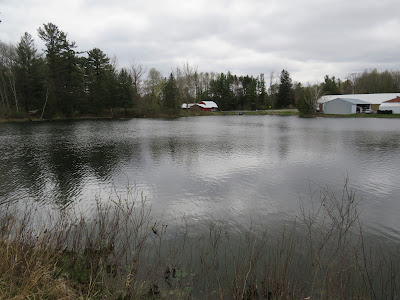
A mile upstream of my last encounter with the Pine River’s south branch, I’m standing on Isabella County’s Rolland Rd. bridge as its water flows east toward the rising sun. The morning weather is partly sunny with calm winds and temperatures in the mid 50’s as I look overhead where a perching male Red-winged blackbird announces his presence. The more colorful and vocal male blackbirds are the first to return from their wintering grounds to establish nesting territories before courting and breeding with drabber females (stock photo) who have yet to arrive. The mating system of Redwings is territorial polygyny, a type of polygyny in which the prolonged association between one male and several females occurs on the male’s territory. As is typical in territorial polygyny, males establish their territories first, and females settle on territories later. Next, canoeing partner, Dave Shepherd and I embark from the riverbank and paddle toward our goal of exploring, for the first time, the 3-acre Riverbank preserve, about a ¼ mile upstream. This property is the least accessible of the 22 owned by the Chippewa Watershed Conservancy. Soon, I come upon a pile of Canada Goose feathers near shore-most likely the result of a nocturnal, predator-prey encounter that illustrates nature’s cycle of life and death. Further upstream, I spot lots of evidence of recent beaver activity including a gnawed stump, a felled tree and a partially constructed dam. This time of year, beavers are also busy marking their territories with a musk-like substance called castoreum. Being meticulous scent markers, they create mounds at the water’s edge, composed of material dredged up from the pond(stock photo) which they mark frequently to stake claim and avoid conflict. Continuing to paddle west through this remote riparian landscape, we are entertained by a chorus of birds including robins, song sparrows and chipping sparrows. After barely making it past our first major tree obstruction, we are soon stopped by an even larger one. Disappointed that our goal is out of reach, we turn around and head downstream toward the car as the chorus of birds continue. Back at the car, Dave saves the day by activating his small drone and sending it flying west high over the river channel to capture a clear aerial photograph of the scenic Riverbank preserve.
No matter the season, no matter the week
It’s wonders of nature that I seek
Maybe the song of a goose in flight
Or Whitetail deer that’s in my sight
Maybe a fresh blanket of snow
Or marsh reeds starting to grow
Maybe colorful leaves in the fall
Or chorus frogs that call
Always plenty to see and hear
No matter the month, no matter the year
D. DeGraaf



